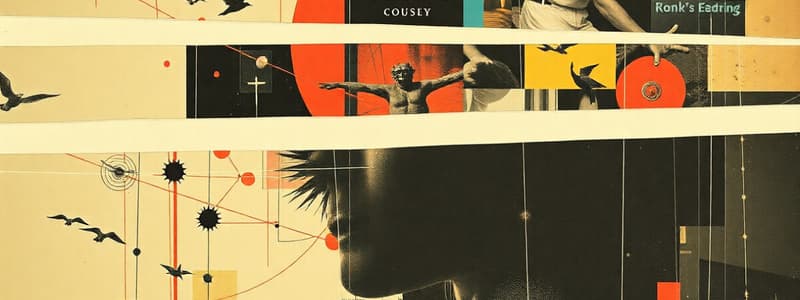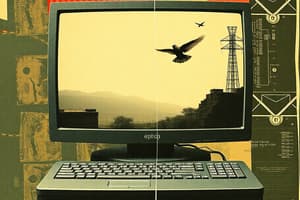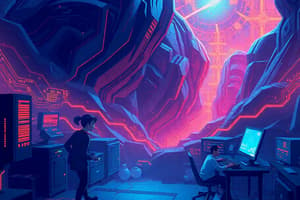Podcast
Questions and Answers
An operating system serves as an intermediary between the user and a computer's hardware but does not perform basic hardware management tasks.
An operating system serves as an intermediary between the user and a computer's hardware but does not perform basic hardware management tasks.
False (B)
Without an operating system, a computer can still be used for intended purposes.
Without an operating system, a computer can still be used for intended purposes.
False (B)
In Windows 10, the Metro interface is the primary screen of the operating system.
In Windows 10, the Metro interface is the primary screen of the operating system.
False (B)
Accessing cloud files in Windows 10 necessitates storing the files locally on the device.
Accessing cloud files in Windows 10 necessitates storing the files locally on the device.
The Windows 10 taskbar typically appears at the top of the screen.
The Windows 10 taskbar typically appears at the top of the screen.
Right-clicking on the taskbar provides access to the Task Manager, where running tasks can be ended.
Right-clicking on the taskbar provides access to the Task Manager, where running tasks can be ended.
The Windows Start Menu can be customized by changing the size of app icons but not by relocating them.
The Windows Start Menu can be customized by changing the size of app icons but not by relocating them.
Files or folders deleted from Windows are permanently removed and do not go to the Recycle Bin.
Files or folders deleted from Windows are permanently removed and do not go to the Recycle Bin.
The command to restore all items from the Recycle Bin is found under the 'View' tab.
The command to restore all items from the Recycle Bin is found under the 'View' tab.
In Windows, using the Shift + Delete key combination permanently deletes files, bypassing the Recycle Bin.
In Windows, using the Shift + Delete key combination permanently deletes files, bypassing the Recycle Bin.
Pressing the F2 key allows you to quickly rename a selected file or folder.
Pressing the F2 key allows you to quickly rename a selected file or folder.
Pressing Ctrl + Alt + Delete is the command to create a new virtual desktop in Windows 10.
Pressing Ctrl + Alt + Delete is the command to create a new virtual desktop in Windows 10.
In Windows 10, pressing the Windows key alone will always open the Control Panel.
In Windows 10, pressing the Windows key alone will always open the Control Panel.
The snipping tool accessory in windows has a default hotkey of $Ctrl + Shift + S$ to initialise without navigating to the start menu.
The snipping tool accessory in windows has a default hotkey of $Ctrl + Shift + S$ to initialise without navigating to the start menu.
In Windows 10, you must first sign up for a Microsoft Developer Account before being able to use the new virtual desktop feature.
In Windows 10, you must first sign up for a Microsoft Developer Account before being able to use the new virtual desktop feature.
Flashcards
Operating System
Operating System
Software that operates a computer, manages hardware, and performs tasks.
Icons
Icons
A set of symbols showing programs, applications, files or folders.
Taskbar
Taskbar
Bar at the bottom of the screen showing the clock, active programs, and more.
Start Menu
Start Menu
Signup and view all the flashcards
Windows Key
Windows Key
Signup and view all the flashcards
Windows Key + D
Windows Key + D
Signup and view all the flashcards
Windows Key + S
Windows Key + S
Signup and view all the flashcards
Windows Key + I
Windows Key + I
Signup and view all the flashcards
Snipping Tool
Snipping Tool
Signup and view all the flashcards
Zipping files
Zipping files
Signup and view all the flashcards
Right-Click on Desktop
Right-Click on Desktop
Signup and view all the flashcards
Virtual Desktops
Virtual Desktops
Signup and view all the flashcards
Study Notes
- Taibah University, Applied College offers a Computer Skills course (CMP 100) as part of the Events Management and Organizing program. The academic year is 1446.
List of Topics
-
Part One covers Principles of Information Technology and Operating Systems.
-
Chapter 1: Principles of Information Technology
-
Chapter 2: Operating Systems
-
Part Two focuses on Office Skills.
-
Chapter 1: Office skills: Word processing software
-
Chapter 2: Office skills: Presentation PowerPoint
-
Part Three discusses Excel 2019.
-
Chapter 1: Excel: About MS-Excel 2019
-
Part Four covers Problem Solving.
-
Chapter 1: Principles and concepts of general problem solving
-
Chapter 2: Building problem solving using computers
-
Chapter 3: VISIO drawing program
-
Part Five focuses on Information Security.
-
Part Six discusses E-Learning and E-Commerce.
-
Chapter 1: E-learning
-
Chapter 2: E-commerce
Operating System
- Operating system manages computer hardware and software components.
- It serves as an intermediary between the user and computer hardware.
- An operating system is responsible for performing basic tasks, like managing computer hardware.
- It manages task-handling priority, controlling input and output hardware.
- A computer cannot function for its intended purposes without it.
Functions of an operating system
- Operating systems boot and start up the computer.
- It acts as an intermediary for the user to enable software functionality.
- The operating system manages resources and tasks.
- It monitors the entire system.
- Responsible for maintaining system confidentiality by restricting unauthorized access to data and software.
- Organizes potential computer programs.
- Allows several programs to run at the same time.
- Detects malfunctions, running troubleshooting programs when needed.
Windows 10 Features
- Can be used in smartphones and tablets
- Easy synchronization and usage of devices
- Has a desktop screen as its main interface
- Replaced the Metro interface
- A notification center allows users to receive various application notifications within the system's notifications
- Gives one access to files in the cloud without needing to store them locally.
Running Windows 10
- Run the system by pressing the device power switch.
- Displays the lock screen containing information (time, date, power status).
- A prompt to enter username and password appears if an account has been previously created.
- Pressing Enter displays the operating system home screen, also known as the desktop.
Understanding Windows 10
-
The Windows operating system home screen is called the desktop, it includes:
-
Icons: Symbols that show system programs or application programs, as well as files or folders.
-
Taskbar: A bar that usually appears at the bottom of the screen.
-
It displays the clock, date, some features related to the computer.
-
Includes some applications and programs installed by the user. Includes active programs as well.
-
The Start Menu is located here
-
A right-click on the taskbar displays a menu with several options:
-
Task Manager: Ends any active task on the computer by selecting the task, then clicking on the "End Task" option.
-
Show or hide the "Task View" button: Lets one create multiple desktops.
-
Can choose which toolbars to show or hide on the taskbar.
Customizing the Start Menu
- The Start menu helps one access applications and programs that can be customized, whether installed, or downloaded, on the the start screen .
- The Start menu contains the “Settings" and "Power" options.
- Options enable the user to shut down or restart the system, and perform commands.
- Changing icon/app size on the Start screen:
- Select the icon to resize, then right-click; a main menu appears.
- Choose "Resize"; a submenu shows options like "Small, Medium or Large."
- Relocating icons/apps on the Start screen:
- Select the icon in the start screen, press and hold the left click.
- drag the mouse to the desired location, then release the mouse. Termed: drag and drop.
Further Customization
- Turning off live dynamic tiles:
- Select the icon you want to turn off dynamic updates.
- Click on "More."
- Select the "Turn off live tiles" option.
- The icon's content turns off, and the application name will appear on the icon.
- Installing applications on the Start screen or taskbar:
- Select the application to install.
- Then, choose the “Install on Start screen" option.
- The application/program will be created on the Start screen.
- The same principle applies for adding the app to the taskbar.
Removing Items
- Removing a program/application from the Start screen:
- Select the app to remove, then right click, a menu appears.
- choose "Remove from Start screen."
- Removing an application/program from the taskbar:
- Select to remove, then right click.
- The process is complete when “Remove from taskbar" is selected.
Navigation
- Users use shortcuts for quick access to windows.
- Primarily press the Windows key with another key.
- Pressing the Windows key alone will open the Start menu.
- Shortcuts Include:
-(Alt + Tab): Navigate active programs; (Flip).
-( +Tab): Allows navigation with the windows/programs in a larger size.
-(D+ ): Go to the desktop screen / return to the previous screen.
-( +M): Minimizes all windows to the taskbar, showing the desktop screen.
-(E+ ): Opens the "File Explorer" window.
- This is the window where folders and files stored are. -(S+ ): Enables the search feature in Windows 10. -(I+ ): Opens the computer settings window. -( + L): Opens/activates the login screen (lock screen). -(arrow + ): Pulls the active window in the direction of the arrow. -( + D + CTRL): Creates a new virtual desktop for Windows 10. -( + F4 + Ctrl): Closes the current virtual desktop; some laptops require pressing (Fn) + (F4). -(arrows + Ctrl + ): Navigates between user-created virtual desktops.
Shutting Down
- Shutdown by user for any work, the reason might be due to saving power or maintain user privacy.
- One can shut down or choose another command by:
- "Start Menu," or press the Windows key.
- a menu will appear; clicking on the “Power” icon displays options to to Sleep, Shutdown and Restart. Commands can be hovered over for function descriptions.
- Selecting the taskbar icon, provides other options.
- Press ALT+F4 to access these commands.
Utilizing Multiple Desktops
- Windows 10 OS can function using multiple virtual desktops. Each desktop has files, active windows, and applications visible
- The feature enables users to function in various work environments
- Opening a new virtual desktop involves:
- By clicking the “Task View” icon in the taskbar
- All active windows becomes minimized, and the "New Desktop" pops up. -A left click creates the new desktop.
- There will be a bar with Desktop windows for your selection.
- The new virtual desktop is created by pressing (D + Ctrl + )
- Switching:
- By clicking "Task View."
- Select choice.
- You can move to the virtual desktop by pressing arrows + Ctrl +
- Closing:
- By clicking "Task View" in the taskbar. "
- Move the mouse to display icon of the virtual desktop
- Press Ctrl+L4 + to close active desktops
Desktop Elements
- A Windows operating system home screen/ graphical interface is a desktop screen, which uses icons to display programs
- The desktop screen also contains a taskbar.
- Accessing desktop properties:
- Open the Start Menu, then click the Settings icon.
- In Settings window, choose "Personalize".
- can also be done by pressing (I + ) keys.
- It is also possible to go to "Personalization" window
- right-clicking an open space on the desktop screen
- a menu will appear; select "Personalize"
Customizing Backgrounds
- To change the desktop background:
- Open the Personalization window; select “background".
- The Background option is active by default.
- Changing settings is displayed, in addition to a preview screen.
- Choose wallpaper.
- Change the settings “Select the appropriate", by changing sizes you want
- set background type such as color, or slideshow Can choose picture folder, then press the “Choose this folder" button.
- Note: User can activate the feature "Allow slideshows on battery power" on laptops
Customizing Windows
- Changing windows, taskbar, and start menu colors:
- From the "Personalize" window; choose “Colors”.
- choose one of the “ Windows colors."
- This will change “Start screen, taskbar, action center, and address bars"
- The Lock screen indicates: -It is the screen where you log into the computer, shows the: -time -date -weather, and whether or not connect to the network
- Screen saver: Saves electrical power and extends screen life.
- To change ( and start) screen saver:
- Open “Personalization window“, click “Lock screen".
- To change to picture , for example, pick images from the " Browse" button.
- This adds a picture during a lock screen
Working with Files And Folders
- Creating:
- By Selecting (Desktop, Document).
- By Right-click and pressing "New".
- You can file as necessary, the folder creation is successful
- Rename by keyboard.
- Editing:
- Select folder name, right click it, and select rename.
- Rename by ENTER
-
Double click
-
Right click, Properties, edit box.
-
Copy and Paste:
- Right click, COPY
- Go to the desired folder
- Right click, then PASTE.
- Cutting uses CTRL+X and CTRL+V to achieve same goal
Deleting Files
-
Right click file, then select delete
-
This will simply recycle the file; it won’t be permanently deleted.
-
To truly delete, you must visit Recycle Bin: Select, Admin, select “Restore" tab.
-
By ADMIN then Delete all
-
To fully delete with not recycle: select requirement, them press shift + delete, confirm
File Types
- Severals types of files, has their own function Icon | File Type ---|--- File | Internet File | Sheet | System file | Video File | Multimedia files | Audio | Audio files | P |Program file| JPG | Slide shows | Image | Picture file | W file | Word processor | Xfile| Electronic spreadsheet program file | A file | Database program file |
Search Settings
Access by:
- Select “Search in Windows" found on taskbar.
- Then click the start menu to display needed target or:
- Press S+ to make search bar available
Snipping Tool
- The snipping tool allows users to take a snapshot of their screen.
- By selecting Snip on Accessories area.
- You can drag an area to capture. the section will have a new Windows Some areas allow edits.
- Save from menu
- Set from Tools; Options.
Zipping Folders
- To zip folder: by RAR
- Right click required file, select Winrar, add to command; RAR is selected.
- DECOMPRESS: 1.
- Open file, extract button
- Select desired location, select "ok".
Referenced
- King Abdelaziz University – Computer Science Unit (2021). Computer Skills (9th edition). Khawarizm Academic
Studying That Suits You
Use AI to generate personalized quizzes and flashcards to suit your learning preferences.




